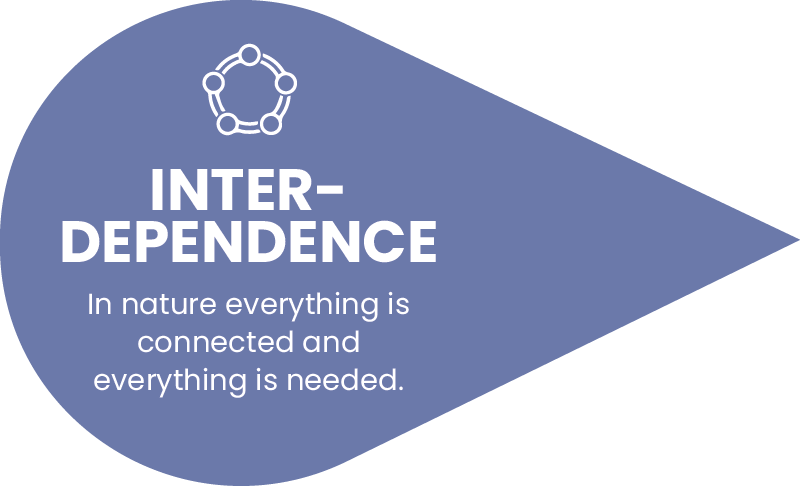
The Seven Harmony Principles
The aim of the Bloom approach to education is to promote harmony between people and between people and the natural world; and to find harmony within one’s own being. The harmony principles are ways of understanding harmony and implementing that harmony in practice, through values that arise from them. Education based on harmony and its principles is rich and purposeful as it gains a new layer of meaning and coherence.
What is harmony?
Harmony is about wholeness. It is created when parts of a whole work together to produce something beautiful, enjoyable and beneficial for all. The ‘whole’ could be a class of students, a school, a local community, an individual human being, a woodland, ocean or other ecosystem, a single living cell, a building, work of art or piece of music. What constitutes a ‘whole’ requires some reflection: we need to think about all the dimensions of that whole for example, for a human being there is not only a physical dimension but also an emotional, mental and spiritual dimension.
The Seven Harmony Principles
There are seven principles or concepts which can be seen to underlie and contribute to overall harmony in nature and in the human world. These are:
DIVERSITY >
HEALTH >
CYCLES >
ADAPTATION>
INTERDEPENDENCE >
ONENESS >
GEOMETRY >
A synopsis of each principle follows:
DIVERSITY
This principle is about learning to appreciate the strength and richness that comes from diversity – in the natural world, in a class, in a family, in a community and so on. The greater the biodiversity and species richness there is in an ecosystem the more resilient and beautiful it is. It applies similarly to diversity of ideas, of works of art, literature, language, culture, religion, even style of dress. If the richness that diversity brings is appreciated, there can be shared enjoyment in it. Finding out about and valuing the particular quality each diverse form, person, idea etc brings to the whole, allows appreciation of the strength in diversity.
Instead of difference being a cause of division it becomes a reason to work together for the good of the whole.
A further step can be taken from here to the Principle of Oneness by encouraging students to look beyond differences to that which is in common. In the natural world all the millions of green plant forms from weeping willows to mosses, for example, have certain fundamental qualities in common: they are all able to make food from sunlight and so they are THE life form on which all other life forms depend. What is the common thread in the human world which is so full of diverse cultures, ideas, body-shapes, sizes, colours and forms? The common thread is our humanity which gives us the ability to think, to reason, to be creative; the desire to love and to be loved; and to value life. One step further leads us to ask what human beings have in common with the natural world? Discussions might cover the idea that we share life itself as well as the materials on which life depends.
HEALTH
Health is about wholesomeness and well-being. Anything that is healthy is more able to function at full potential.
In the natural world a healthy, wild ecosystem is sustainable, beautiful and harmonious. When extreme conditions prevail there are survival tactics so that balance can be restored when favourable conditions return. In farming, whether growing crops, rearing beef or dairy cattle, chickens, pigs, or market gardening, methods can be chosen that work WITH nature so as to minimise damage or even enhance the health of soils, water supplies and wild life.
In their personal life students can consider what constitutes a healthy life. What makes life more harmonious? This relates closely to the balance and equilibrium discussed in the Principle of Cycles. A holistic view of health is essential here, that is, health of body, mind and emotions must be considered. A balance needs to be found for all three aspects, all three aspects should be nourished. How this can be done, needs reflection.
CYCLES and SUSTAINABILITY
In the natural world systems are self-regenerating and sustainable because materials pass from one organism to another in cycles. For example, a rose bush uses minerals from the soil, water and carbon dioxide to make its food from which leaves, stems, flowers and fruits grow; then an aphid eats a rose leaf, a ladybird eats the aphid, a bird eats the ladybird and so on; when each organism in the chain dies their bodies are fed on by fungi and bacteria so that they decompose and the materials from which they were made return to the soil, water and air to be re-used. There is perpetual recycling. No unusable waste or pollution is created.
How could our students live so they fit in more closely with nature’s cycles? How could they create less waste and less pollution?
Cycles that apply to human life relate to the ‘virtuous circle’. For example, when kindness and care are given, if there is appreciation of and gratitude for that care and kindness, further kindness and care follow. In fact the elements of the cycle grow. It is a kind of positive feedback. What other examples can students think of and how can these be put into practice?
In the natural world cycles also keep things within limits so nothing is done to excess. What do our students do to excess? What effect do such actions have on themselves, on others and on the natural world? Buying too many clothes, consuming too much of anything, having too much ‘screen time’ are examples that can be investigated. The often-used term ‘consumer’ is worth thinking about.
ADAPTATION
In the natural world organisms are beautifully adapted to the situation they find themselves in; animals eat food and build their homes from what is around them. Their bodies are suited to those foods: they have the right mouth parts, digestive system, form of locomotion, senses and so on. In the same way we have very specific bodies and faculties that make us human. Our adaptations include a voice box, tongue, throat and brain that facilitate the power of speech; we have the power of reason; hands with fine motor skills so we can hold and control instruments to write, type, sew, create fine art and craft work, play musical instruments, cultivate the land and so on; the upright stance that allows grace of movement in dance, gymnastics, sport etc. These unique and wonderful human faculties give us immeasurable advantages and power over other living things who do not have the same combination of faculties. And these powers enable us to manipulate the natural world in all sorts of ways. But surely the privilege of being human incurs weighty responsibilities? What are those responsibilities?
In the natural world systems adapt to change and then re-balance, by re-establishing an equilibrium. If a population explodes as a result of an excess of food, it will then diminish because there will a food shortage. The whole ecosystem fluctuates about and will return to an equilibrium. Within our bodies there are ongoing, life-prolonging mechanisms that respond to changes such as fluctuating blood sugar levels, blood water levels and temperatures so that the body’s equilibrium point or balance is always re-established.
Thus re-balancing is essential for surviving and thriving. How might this apply to human society? Where is balance needed at this time in human history?
Considering the damage human beings have wrought on the natural world, the huge imbalances we have created in the waters, air, soils and rocks of the earth; in ecosystems and communities that comprise them, what can we do to help re-establish balance and health to the planet?
If circumstances change, over time, populations may adapt to the changes through naturally occurring changes to DNA. In human terms, when we are faced with changes, often not of our own making, we need to be able to adapt, to be flexible and embrace the changes. Resilience needs to be cultivated so that emotional and mental equilibrium are re-established. The very idea of there being a natural emotional and mental equilibrium within us is something to be explored.
The thread of history is contained in each organism, physically in its DNA and perhaps in other ways. Thus each individual is linked to its past and has a link to the future through its offspring. As humans we inherit not only our DNA but our values, many of which have been passed down over countless generations and stood the test of time. Students could investigate some of these such as trust, love, truthfulness, respect for others and for the natural world, self-control and loyalty. Where do they come from? How do they get passed on? What do they mean in practice? What will they pass on to the next generation?
INTERDEPENDENCE (INTERCONNECTEDNESS)
The fundamental idea is that we are inextricably linked to each other and to the natural world; we are part of the same whole - and because of this, every action matters, every action has a wider consequence. In the natural world this is evident: for example, we know that pesticides have devasted populations of bees; the knock-on effect of losing these essential pollinators is hard to over-estimate. The action of using pesticides to grow more crops does not take place in isolation. In light of the principle of interconnectedness (or interdependence) we can lead our students to see that everything they do, everything they say to someone, every feeling they have about something, actually has an effect – on others, on nature, on the whole, and the happiest condition is to know that your actions are having a beneficial effect.
This leads on to taking a fresh look at relationships: how can we create harmonious relationships with each other, within our families and in the wider world? And how can we live harmoniously with the natural world?
Furthermore, we are dependent on the whole, we need the whole, and it needs us. Our students need to see how utterly dependent they are on the natural world, on air, water, soil, space, warmth and light. What if someone is pushed underwater and can’t get to the air? What if there was no water to drink, to wash with, to flush the toilet with? Looking then to the human world, how dependent are we on the multifarious jobs that members of society perform from bus driver, builder, farmer, sewer worker, to doctor or IT expert? What would our lives be like if any one of those jobs was not done for us? What personal responsibility should we and our students bear for the natural world and for those on whom we depend?
Every ‘element’ or member of the whole, is of value – our students need to know that they really matter, who they are matters, what they are able to contribute matters, because they are vital to the well-being of the whole. A rotting leaf in a woodland is of as much value to the whole woodland as the great oak tree from which it fell. In light of this aspect of interconnectedness, we can get our students to find out what they have to give that is of value to the whole.
ONENESS
An understanding of oneness can come from awareness of the connection between the natural world and human beings. Studying the other six Principles of Harmony show this connection. The fact that we are interdependent, that the health of the natural world is tied up with our own health, that our actions have consequences, that we are bound up in the cycles of nature, that we contain the same elements of symmetry that the rest of nature has, all tell us about oneness. Knowing that all bodies from those of the most distant star to a paving stone, human body or blade of grass are made of the very same materials, can also bring a strong sense of oneness.
Experiences of oneness in human life are common: playing sports for a team, being part of a dance or instrumental group, doing a project together, any activity where people are working for a common, useful purpose can bring a sense of oneness. People often find they are less concerned about their own personal wishes, requirements, even their disagreements, for the sake of that oneness. And because they put these habitual limitations aside, they may experience a feeling of satisfaction, well-being and worth, which is shared by all participants. They feel connected with the others and they lose the feeling of separation or isolation.
Deeper experiences of oneness are possible for example, through some of the mindfulness exercises. Also through just being in a peaceful place such as by a lake, in a woodland, park, church or other sacred place.
In whatever way oneness is experienced or through whatever example it is acknowledged, a person is brought closer to harmony.
GEOMETRY and BEAUTY
Learning about this principle starts with seeing and appreciating the beautiful geometrical forms in the natural world. In order to create awareness of forms in nature, lessons involve constructing simple geometrical patterns with a pair of compasses. A next step is to look at the golden spiral in shells, pine cones, seeds in the head of sunflowers, the arrangement of petals in a rose, the shape that forms when our hand makes a fist or a galaxy of stars, all of which are awe-inspiring. Amazing symmetry is also all around us in the most common things: the face of a pet cat, a flower, an apple or tomato when cut in half, our own faces, our body with two arms and two legs and so on.
Simply connecting with the beauty in nature, appreciating that we participate in that beauty, brings harmony of itself.
It may encourage students to choose to look at, listen to, engage in things in their lives that have beauty.
Classes can consider examples of everyday actions that are beautiful. Listening to someone with full attention rather than texting or looking at messages on a phone; doing something generous for someone; showing gratitude to someone such as a teacher or parent, not holding resentment or anger are possible examples.
How we use the concept of harmony and its principles in our workshops and other programmes
We believe we can learn a lot from nature. Firstly, our senses can reveal much more information than we might expect – we could call this objective knowledge. Connecting with nature through the senses in a mindful way also gives a personal experience of nature, we might say, a subjective knowledge.
Secondly, by relating what is conveyed by the senses to the concept of harmony and any relevant principles, a further, deeper knowledge of what nature can teach us is revealed.
For example, from smelling soil we observe richness, freshness, liveliness as well as a mustiness, decay, oldness. These qualities point to principles such as cycles that take place in soil and to the processes that make this cycle possible ie the breakdown of organic matter; the many components of soil that can be seen, touched and smelt point to interdependence and diversity.
The principles therefore provide a springboard with which we can enquire more deeply into the workings of nature.
The principles can be explored even further by asking if they have relevance to human life. For example, cycles can be seen in human birth, growth and death; the same seems to happen to the things that humans create from buildings to civilisations; virtuous cycles of behaviour teach us about the importance of gratitude and of praise; cycles of harm teach us about the wider implications of doing harm.








